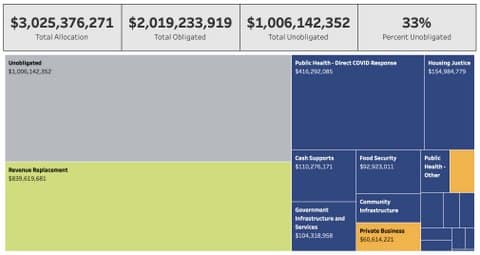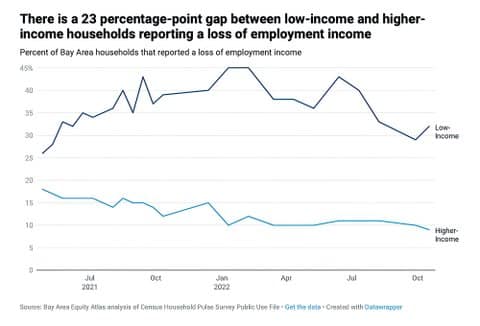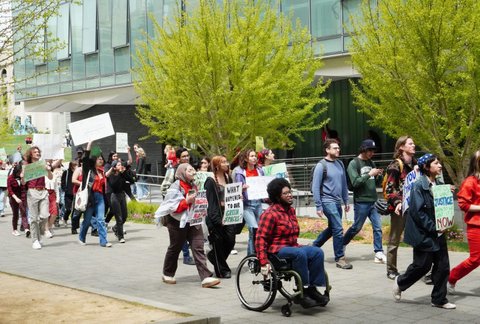
18 Jun Bay Area Cities, Counties Could Advance Equity With $1B in Unspent Federal Relief

One-third of the Bay Area’s $3 billion in federal State and Local Fiscal Recovery Funds were uncommitted to projects in December, according to the latest data from the U.S. Treasury Department (Bay Area Equity Atlas via Bay City News)
By Keith Burbank
Bay City News
About $1 billion of largely discretionary money from the American Rescue Plan Act was still uncommitted to Bay Area projects in December, according to the Bay Area Equity Atlas, a tool to track racial and economic equity in the region.
The uncommitted funds give city and county leaders an opportunity in the next three and a half years to make the region a fairer place to live.
The COVID-19 pandemic shed light on and exacerbated longstanding inequities in Black and Hispanic communities, among others. With the money, leaders could develop projects to advance fairness.
The American Rescue Plan Act passed by Congress in 2021 provided money to help Americans overcome the COVID-19 pandemic, including $350 billion for states and local governments through Coronavirus State and Local Fiscal Recovery Funds.
The Bay Area’s $1 billion in uncommitted ARPA funds is a small part of the SLFRF that states, cities and counties must commit to projects by the end of next year and spend by the end of 2026 or they lose the money in either case.
>>>Read: Richmond Continues to Consider Uses for Rescue Plan Funds
Fifty percent of ARPA dollars were dispersed in 2021 and the balance in 2022.
“The pandemic decimated Black and brown families, further entrenching racial and economic inequality,” said Jennifer Tran, a director at PolicyLink, which produces the Bay Area Equity Atlas along with the San Francisco Foundation and the USC Dornsife Equity Research Institute.
“Bay Area governments should make targeted and permanent investments with the remaining $1 billion SLFRF dollars that move communities toward a more equitable and sustainable future — one that ensures the health and well-being of the region and all of its communities for generations to come,” Tran said.
>>>Read: Data Shows Some Bay Area Populations Struggling Financially in Post-COVID Economy
Two-thirds of the Bay Area’s roughly $3 billion in SLFRF was already committed by December by the region’s cities and counties.
State and Local Fiscal Recovery Funds are just part of the $1.9 trillion federal ARPA package following dispersion of Coronavirus Aid, Relief, and Economic Security Act funds, which went to states and large cities in 2020.
Data on uncommitted and unspent SLFRF was collected by the Bay Area Equity Atlas from the U.S. Treasury Department for nine counties and 34 of the 101 cities in the Bay Area.
“The American Rescue Plan Act funds have been instrumental to keeping the Bay Area’s communities and economy afloat during the pandemic,” said Berkeley Mayor Jesse Arreguin, who is president of the Association of Bay Area Governments, a regional planning agency.
Arreguin wants to see any remaining funds spent for transit operations and emergency rental assistance.
ARPA provided $30.5 billion for transit and that funding is separate from SLFRF. Ninety-three percent of ARPA money for transit has been committed and 67 percent has been spent.
“Regional transit systems relied on lifeline funding which is going away and the eviction cliff requires more funding to help owners and renters cover rent debt,” Arreguin said. “These are ongoing lingering impacts from the COVID emergency.”
>>>Read: Transit Policymakers Urge More Public Transit Funding From the State
San Jose Mayor Matt Mahan said his city has used ARPA funds to “keep people housed, address food insecurity, and provide other essential services to our most vulnerable neighbors.”
San Jose officials in May spent or committed all of the roughly $45 million in remaining SLFRF from the $212 million they had received overall.
San Jose officials were afraid they would have to return some of the uncommitted or unspent money following Congress’ approval of a deal to suspend the debt limit.
Cities and counties may spend the money among four broad categories: 1) replacing lost revenue, 2) public health and economic aid, 3) premium pay for essential workers, and 4) investing in water, sewer and broadband infrastructure.
Under U.S. Treasury rules, San Jose could allocate all $212 million to make up for lost revenue to pay for services.
San Jose budget director Jim Shannon and director of finance Rick Bruneau said in a May 24 memo to Mahan and the City Council that the city lost more than $212 million in revenue from the pandemic. The memo said nearly $88 million will go toward police patrol costs.
Oakland allocated all its money to replace general fund revenue. San Francisco received about $624 million in SLFRF and spent all of it on revenue replacement across city departments.
In Santa Clara County, which received about $374 million, 53% of its SLFRF were unallocated in December. Thirty percent of Alameda County’s roughly $325 million was uncommitted at the end of last year.
Copyright © 2023 Bay City News, Inc. All rights reserved. Republication, rebroadcast or redistribution without the express written consent of Bay City News, Inc. is prohibited. Bay City News is a 24/7 news service covering the greater Bay Area.






No Comments